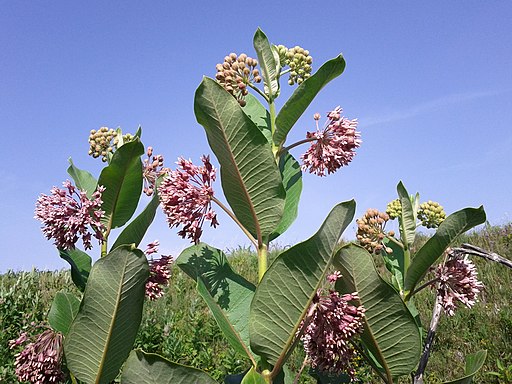 |
Common milkweed | Status LU: uncertain. 1st record: LU & ITW <1836. |
 |
Gewéinlech Seideplanz | Status Eur.: established. 1st record: unkn. IAS of EU concern (2017). |
 |
Asclépiade commune | RA: ISEIA: B0, Alert List. Harmonia+: 0,19 |
 |
Gewöhnliche Seidenpflanze | Wikipedia: |
 |
Gewoon zijdeplant | Back to the list of neophytes |
Contents
Report the species
→ Report Asclepias syriaca to the National Museum of Natural History.
Brief description

Asclepias syriaca on ballast near Karnabrunn, district Korneuburg, Lower Austria. Photo: Stefan.lefnaer, 30 June 2012. commons.wikimedia.org
In 2014, Switzerland added Asclepias syriaca L. to its List of Invasive Alien Plants (EPPO 2019, Anonymous 2014).
IAS of Union concern
In 2017, Asclepias syriaca L. was added to the list of invasive alien species of Union concern (Anonymous 2017) which implies that member states shall take all necessary steps to prevent it’s unintentional introduction or spread.
Status and distribution in Luxembourg
Asclepias syriaca L. was first mentioned for Luxembourg by Tinant (1836: 134): “This plant, native to Syria and cultivated in our gardens, is found wild on the rocks around Bellevue [Ed.: Petrusse valley in Luxembourg City], where it is quite common […]. It also grows in the park of Clervaux.”1 Klein (1897: 54-55) mentions the Common milkweed to be grown as an ornamental plant.
Lambinon & Verloove (2012: 534) mention this melliferous species as very rare in the territory of the flora; recently in expansion in Belgium.
The databases contain no observations of Asclepias syriaca L. for Luxembourg (MNHNL, iNaturalist & GBIF, 2020).
Risk assessment
ISEIA protocol
B0 (3+2+2+2) = Alert List. First assessed 22 November 2019 by Christian Ries.
Harmonia+ protocol
Overall risk score 0,19 = (Overall Invasion score 0,52 x Overall Impact score 0,37) (Ries et al. 2020).
 Invasion
Invasion0,37

 Impact
Impact0,19

 Risk
RiskWorldwide distribution
Bibliography
- Anonymous, 2014. Asclepias syriaca in: Info Flora – Das nationale Daten- und Informationszentrum der Schweizer Flora. URL: https://www.infoflora.ch/de/assets/content/documents/neophyten/inva_ascl_syr_d.pdf
- Anonymous, 2017. Commission implementing regulation (EU) 2017/1263 of 12 July 2017 updating the list of invasive alien species of Union concern established by Implementing Regulation (EU) 2016/1141 pursuant to Regulation (EU) No 1143/2014 of the European Parliament and of the Council. Official Journal of the European Union L 182: 37-39 (13.7.2017).
- CABI, 2010. Asclepias syriaca L. [original text by Claire Teeling]. In: Invasive Species Compendium. Wallingford, UK: CAB International. URL: www.cabi.org/isc [accessed 2019-11-22]
- EPPO, 2019. EPPO Global Database: Asclepias syriaca L. URL: https://gd.eppo.int [accessed 2019-11-22]
- Klein, E. J., 1897. Die Flora der Heimat (sowie die hauptsächlichsten bei uns kultivierten fremden Pflanzenarten biologisch betrachtet. Eine Anleitung zur selbständigen Beobachtung der Lebens- und Anpassungserscheinungen in der Pflanzenwelt). 552 S., Buchdruckerei Justin Schroell, Diekirch.
- Lambinon J. & F. Verloove, 2012. Nouvelle flore de la Belgique, du grand-duché de Luxembourg, du Nord de la France et des régions voisines. Sixième édition. Avec la collaboration de L. Delvosalle, B. Toussaint, D. Geerinck, I. Hoste, F. Van Rossum, B. Cornier, R. Schumacker, A. Vanderpoorten et H. Vannerom. Jardin botanique national de Belgique, Meise. CXXXIX + 1195 pp. ISBN : 9789072619884.
- MNHNL, iNaturalist & GBIF, 2020. Asclepias syriaca in MNHNL-mdata, online portal combining species observation from Recorder-Lux, iNaturalist and GBIF. National Museum of Natural History, Luxembourg. URL: https://mdata.mnhn.lu [Accessed 2020-02-28]
- Ries, C. & Y. Krippel, 2021. First records of 56 invasive alien vascular plants in Luxembourg. Bulletin de la Société des naturalistes luxembourgeois 123: 115-127. [PDF 241 KB]
- Ries, C., Y. Krippel & M. Pfeiffenschneider, 2020. Risk assessment after the Harmonia+ protocol of invasive alien vascular plant species in Luxembourg. Bull. Soc. Nat. luxemb. 122: 197-205. [PDF 132 KB]
- Tinant, F. A., 1836. Flore luxembourgeoise, ou, Description des plantes phanérogames, recueillies et observées dans le grand-duché de Luxembourg, classées d’après le système sexuel de Linnée. 512 p. Luxembourg, J. P. Kuborn.
Suggested citation of this webpage
Ries, C., M. Pfeiffenschneider & Y. Krippel (Eds.), 2025. Asclepias syriaca L. In: neobiota.lu - Invasive Alien Species in Luxembourg. National Museum of Natural History, Luxembourg. URL: https://neobiota.lu/asclepias-syriaca/ [Accessed 2025-07-07].
Page content last updated on 2021-07-14. Last proofread by Caroline Grounds on 2019-11-27.
- Original text: “Cette plante originaire de Syrie et cultivée dans nos jardins, se trouve sauvage sur les rochers aux environs de Bellevue, où elle est assez fréquente […]. Elle croît aussi dans le parc de Clervaux.”[↩]


